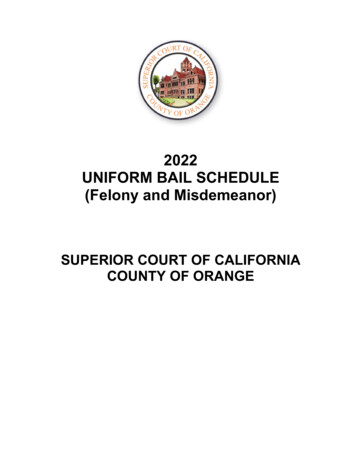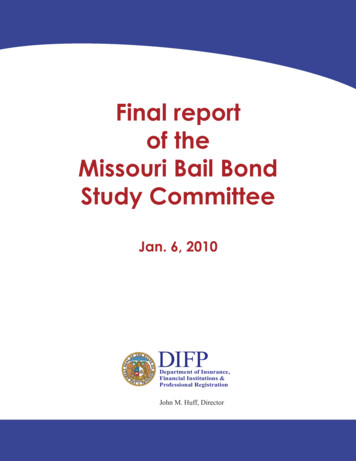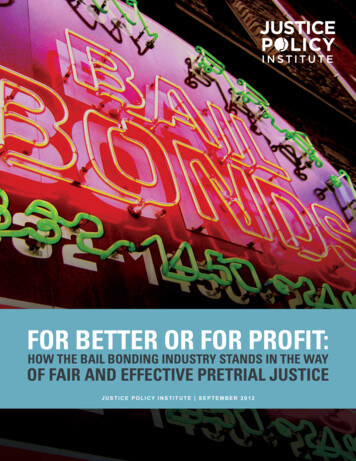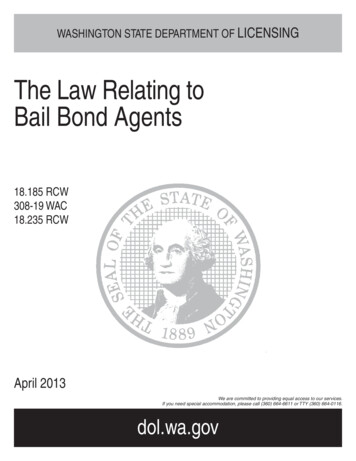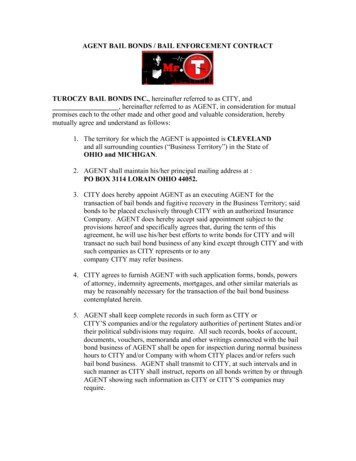
Transcription
1The History of Bailand Pretrial ReleaseSeptember 23, 2010Timothy R. Schnacke,Michael R. Jones,Claire M. B. Brooker
The History of Bail andPretrial Release1A. Introduction1While the notion of bail has been traced to ancient Rome,2 the American understanding of bailis derived from 1,000-year-old English roots. Astudy of this “modern” history of bail reveals twofundamental themes. First, as noted in June Carbone’s comprehensive study of the topic, “[b]ail[originally] reflected the judicial officer’s prediction of trial outcome.”3 In fact, bail bond decisionsare all about prediction, albeit today about theprediction of a defendant’s probability of makingall court appearances and not committing anynew crimes. The science of accurately predictinga defendant’s pretrial conduct, and misconduct,has only emerged over the past few decades,and it continues to improve. Second, the conceptof using bail bonds as a means to avoid pretrialimprisonment historically arose from a series of1 While much of the text in this section is attributed to itssource by footnote, any un-attributed statements werederived primarily from the following sources: F. Pollock & F.Maitland, The History of English Law (2d Ed. 1898) [hereinafter Pollock & Maitland]; Caleb Foote, The Coming Constitutional Crisis in Bail: I and II, 113 Univ. Pa. L. Rev. 959, 1125(1965) [hereinafter Foote]; Wayne H. Thomas, Jr., Bail Reformin America (Univ. CA Press 1976) [hereinafter Thomas];Gerald P. Monks, History of Bail (1982); June Carbone, SeeingThrough the Emperor’s New Clothes: Rediscovery of BasicPrinciples in the Administration of Bail, 34 Syracuse L. Rev.517 (1983) [hereinafter Carbone]; Stevens H. Clarke, PretrialRelease: Concepts, Issues, and Strategies for Improvement, 1Res. in Corrections, Issue 3:1; Evie Lotze, John Clark, D. AlanHenry, & Jolanta Juszkiewicz, The Pretrial Services Reference Book, Pretrial Servs. Res. Ctr. (Dec. 1999) [hereinafterLotze, et al.]; Marie VanNostrand, Legal and Evidence BasedPractices: Application of Legal Principles, Laws, and Researchto the Field of Pretrial Services (Crime & Just. Inst., Nat’l Inst. ofCorrections (2007)) [hereinafter VanNostrand]; and materialfound on the Pretrial Justice Institute’s website, at http://www.pretrial.org/. Carbone, in turn, cites to E. De Haas,Antiquities of Bail (1940), as well as to Pollock & Maitland foradditional “thorough studies on the origins of bail.” All linksto websites are current to September 23, 2010.cases alleging abuses in the pretrial release ordetention decision-making process. These abuses were originally often linked to the inability topredict trial outcome, and later to the inabilityto adequately predict court appearance and thecommission of new crimes. This, in turn, led toan over-reliance on judicial discretion to grant ordeny a bail bond and the fixing of some moneyamount (or other condition of pretrial release)that presumably helped mitigate a defendant’spretrial misconduct. Accordingly, the following history of bail suggests that as our ability topredict a defendant’s pretrial conduct becomesmore accurate, our need for reforming how bailis administered will initially be great, and thenshould diminish over time.B. Anglo-Saxon RootsTo understand the bail system in medieval England, one must first understand the system ofcriminal laws and penalties in place at that time.The Anglo-Saxon legal process was created toprovide an alternative to blood feuds to avengewrongs, which often led to wars. As Anglo-Saxonlaw developed, wrongs once settled by feuds (orby outlawry or “hue and cry,” both processes allowing the public to hunt down and deliver summary justice to offenders) were settled througha system of “bots,” or payments designed tocompensate grievances.4 Essentially, crimeswere private affairs (unlike our current systemof prosecuting in the name of the state) andsuits brought by persons against other personstypically sought remuneration as the criminalpenalty. In a relatively small number of cases,persons who were considered to be a danger tosociety (“false accusers,” “persons of evil repute,”and “habitual criminals,”) along with personscaught in the act of a crime or the process of2 See Lotze, et al., supra note 1, at 2 n. 3.3 Carbone, supra note 1, at 574.4 Id. at 519-20.The History of Bail and Pretrial Release1
2escaping, were either mutilated or summarily executed.5 All others were presumably consideredto be “safe,” so the issue of a defendant’s potential danger to the community if released was nota primary concern.Nevertheless, the Anglo-Saxons were concernedthat the accused might flee to avoid paying thebot, or penalty, to the injured (as well as a “wite,”or payment to the king). Prisons were “costly andtroublesome,” so an arrestee was usually “replevied (replegiatus) or mainprised (manucaptus),”that is, “he was set free so soon as some sureties(plegii) undertook (manuceperunt) or becamebound for his appearance in court.”6 Thus, asystem was created in which the defendant wasrequired to find a surety who would provide apledge to guarantee both the appearance of theaccused in court and payment of the bot uponconviction. The amount or substantive worthof that pledge, called “bail” (akin to a modernmoney bail bond), was identical to the amount orsubstantive worth of the penalty. Thus, if an accused were to flee, the responsible surety wouldpay the entire amount to the private accuser, andthe matter was done.According to Carbone, “[t]he Anglo-Saxon bailprocess was perhaps the last entirely rationalapplication of bail.”7 Because the amount of thepledge was identical to the amount of the fine5 See id. at 520-521, and accompanying notes.6 Pollock & Maitland, supra note 1, at 584. Indeed, eventhose unable to pay the “bot” were typically handed overto the victim for either execution or enslavement. Carbone,supra note 1, at 521 n. 18. If they fled, they were declared“outlaws,” subject to immediate justice from whoevertracked them down. Apparently, however, certain offenseswere considered to be “absolutely irreplevisable,” requiringsome form of prison to house the offenders. See Pollock &Maitland, supra note 1, at 584-85.7 Carbone, supra note 1, at 520.upon conviction, the system accounted for theseriousness of the crime and fulfilled the debtowed if the accused did not appear for trial. Allprisoners facing penalties payable by fine werebondable, and the bail bond was perfectly linkedto the outcome of trial – money for money.C. The Norman Conquest to1700The system became significantly more complexafter the Norman Conquest, beginning in 1066:In the period following the Norman invasion, criminal justice gradually became anaffair of the state. Criminal process could beinitiated by the suspicions of a presentmentjury as well as the sworn statements of theaggrieved. Capital and other forms of corporal punishment replaced money fines for allbut the least serious offenses, and the delaysbetween accusation and trial lengthenedas itinerant royal justices administered localjustice.8Summary mutilations and executions weregradually phased out, but the overall use ofcorporal punishment increased, giving manyoffenders a greater incentive to flee. Systemdelays also caused many persons to languishin primitive jails, and the un-checked discretion given to judges and magistrates to releasedefendants led to instances of corruption andabuse. Moreover, as the penalties changed,ideas about which persons should be bondablealso shifted. The first to lose any right to bailwhatsoever were persons accused of homicide,followed by persons accused of “forest offenses”(i.e., violating the royal forests), and finally acatch-all discretionary category of persons ac8 Id. at 521 (footnotes omitted).a publication of the pretrial justice institute
3cused “of any other retto [wrong] for which according to English custom he is not replevisable[bailable].”9In medieval England, magistrates rode a circuitfrom county (shire) to county to handle cases.The shire’s reeve (now known as the sheriff ) wasgiven the duty of holding individuals accusedof crimes until the magistrate arrived. Becauseof the broad discretion given to these sheriffsto hold persons pretrial, bail administrationvaried from county to county, and instances ofabuse became more frequent. Indeed, “[b]ail lawdeveloped in the twelfth and thirteenth centuries as part of an assertion of royal control overthe authority of the sheriffs,” which had grownincreasingly corrupt.10Following exposure of widespread abuse in thebail bond-setting process, Parliament passed thefirst Statute of Westminster, which assembledand codified 51 existing laws – many originating from the Magna Carta – and which covered,among other things, bail. Importantly, theStatute departed from traditional Anglo-Saxoncustoms by establishing three criteria to governbailability: (1) the nature of the offense (categorizing offenses that were and were not bailable);(2) the probability of conviction (requiring thesheriff to examine all of the evidence and tomeasure such variables as whether or not the accused was held on “light suspicion”); and (3) thecriminal history of the accused, often referred toas the bad character or “ill fame” of the accused.According to Carbone, “[i]n defining the criteriato govern bail, the Statute of Westminster rearticulated rather than abandoned the conclusionof the Anglo-Saxons that the bail process mustmirror the outcome of the trial. Despite the over9 Id. at 523 (internal quotation and footnote omitted).10 Id. at 522 n. 29.lapping and conflicting concerns of the statute’scriteria, each criterion can be reduced to a simplestandard: the seriousness of the offense offset bythe likelihood of acquittal.”11 Indeed, this standard governed English bail bond determinationsfor the next five centuries.During that 500-year period, Parliament occasionally passed legislation defining the bailabilityof crimes not mentioned in the Statute of Westminster. Mostly, however, Parliament focused onadding safeguards to the bail process to protectpersons from political abuse and local corruption. For example, due to the vague nature of theterms “ill fame” and “light suspicion,” as appliedby local justices of the peace, in 1486 Parliamentrequired the approval of two justices, ratherthan one, to release a prisoner and to certify thebailment at the next judicial session. In 1554,Parliament required that the bail bond decisionbe made in open session, that both justices bepresent, and that the evidence that was weighedbe recorded in writing, essentially introducingthe notion of a preliminary hearing into the law.Over time, additional abuses led to additional reforms. For example, bailability under the Statuteof Westminster was initially based on a recitationof a formal charge. Nevertheless, in 1627, KingCharles I successfully ordered local judges tohold five knights with no charge, circumventingthe Statute, as well as provisions in the MagnaCarta upon which the Statute was based. Parliament responded by passing the Petition of Right,prohibiting detention by any court without acharge. In 1676, an individual known only asJenkes was arrested and held for two monthson a charge that, by law, required admittance tobail. Jenkes’ case, and cases like it, ultimately ledto Parliament’s passage of the Habeas Corpus11 Id. at 526.The History of Bail and Pretrial Release
4Act of 1679, which established procedures toprevent long delays before a bail bond hearingwas held. This reform was only a minor hurdle forsome of the stubborn and unruly judges of thattime, who learned that the monetary amountof a bail bond could also be used to detain adefendant indefinitely. According to Foote, “[t]heAct of 1679 stopped the procedural runaroundto which Jenkes had been subjected, but bysetting impossibly high bail the judges erectedanother obstacle to thwart the purpose of thelaw on pretrial detention.”12 Addressing this matter, the English Bill of Rights of 1689, accepted byWilliam and Mary as they assumed the throne,stated that “excessive bail ought not be required,”a phrase similar to that found in the EighthAmendment to the U.S. Constitution.D. Bail in the United StatesCaleb Foote summarized the state of English lawon bail at the time of American Independence asfollows:[A]s the English protection against pretrialdetention evolved it came to comprise threeseparate but essential elements. The first wasthe determination of whether a given defendant had the right to release on bail, answeredby the Petition of Right, by a long line ofstatutes which spelled out which cases mustand which must not be bailed by justices ofthe peace or (in the early period) by sheriffs,and by the discretionary power of the judgesof the king’s bench to bail any case not bailableby the lower judiciary. Second was the simple,effective habeas corpus procedure which wasdeveloped to convert into reality rights derived from legislation which could otherwisebe thwarted. Third was the protection against12 Foote, supra note 1, at 967.judicial abuse provided by the excessive bailclause of the Bill of Rights of 1689.13Generally, the early colonies applied Englishlaw verbatim, but differences in beliefs aboutcriminal justice (including the belief that theEnglish laws were unnecessarily confusing),differences in colonial customs, and even differences in crime rates between England and thecolonies led to more liberal criminal penaltiesand, ultimately, changes in the laws surrounding the administration of bail. Even before someof England’s later reforms, in 1641 Massachusetts passed its Body of Liberties, creating anunequivocal right to bail for non-capital cases,and re-writing the list of capital cases.14 In 1682,“Pennsylvania adopted an even more liberalprovision in its new constitution, providing that‘all prisoners shall be Bailable by Sufficient Sureties, unless for capital Offenses, where proof isevident or the presumption great.’”15 The Pennsylvania language introduced consideration13 Id. at 968.14 It is noted that the substantive criminal law of this periodof time is often considered barbaric by today’s standards.For example, despite the relatively liberal bail law in Massachusetts, along with homicide that Colony still punishedby death (and therefore made unbailable) the offenses ofidolatry, witchcraft, blasphemy, cursing or smiting a parent,and stubbornness or rebelliousness on the part of a sonagainst his parents. See id. at 981. Moreover, many personswere imprisoned by the colonies for simply being impoverished: “In 1788, a year before Congress was to consider whatwas to become the eighth amendment, Massachusettsenacted legislation which . . . provided for compulsory workin houses of correction for, inter alia, ‘all rogues, vagabondsand idle persons . . . common railers or brawlers, such asneglect their callings or employment, misspend what theyearn, and do not provide for themselves for the supportof their families . . . and of . . . vagrant, strolling and poorpeople.’” Id. at 990. By 1830 there were roughly three timesas many persons imprisoned for debt as were imprisonedfor crime. Id. at 991.15 Carbone, supra note 1, at 531 (quoting 5 American Charters 3061, F. Thorpe ed. 1909) (footnotes omitted).a publication of the pretrial justice institute
5of the evidence for capital cases, and, “[a]t thesame time, Pennsylvania limited imposition ofthe death penalty to ‘willful murder.’ The effectwas to extend the right to bail far beyond theMassachusetts Body of Liberties and far beyondEnglish law.”16 The Pennsylvania law was quicklycopied, and as the country grew “the Pennsylvania provision became the model for almost everystate constitution adopted after 1776.”17This is especially important, given that theUnited States Constitution itself only explicitlycovers the right of habeas corpus in Article 1,Section 9, and the prohibition against “excessivebail” in the Eighth Amendment, which has beentraced back to the 1776 Virginia Declaration ofRights.18 There is no explicit right to bail in theU.S. Constitution, and the Constitution doesnot define which crimes are bailable, nor whichdefendants can be detained.19 Nevertheless,also before the first Congress in the spring andsummer of 1789 was Section 33 of the JudiciaryAct, which granted an absolute right to bail innon-capital federal criminal cases.20 To Foote,16 Id. at 531-32 (footnotes omitted).17 Id. at 532.18 Article 1, Section 9 of the United States Constitutionstates that “[ T]he privilege of the writ of habeas corpusshall not be suspended, unless when, in cases of rebellionor invasion, the public safety may require it.” The EighthAmendment to the Constitution states that “[E]xcessive bailshall not be required, nor excessive fines imposed, nor crueland unusual punishments inflicted.”19 Professor Foote argues that the founding fathers meantto include a right to bail provision, such as that found inthe Statute of Westminster, but inadvertently left it out. SeeFoote, supra note 1, at 971-989.20 The Judiciary Act provided a detailed organization of thefederal judiciary that the constitution had sketched in onlygeneral terms. Section 33 of that Act read: “And upon all arrests in criminal cases, bail shall be admitted, except wherethe punishment may be death, in which cases it shall not beadmitted but by the supreme or a circuit court, or by a jus-“advancing the basic right governing pretrialpractice in the form of a statute while enshrining the subsidiary protection ensuring fairimplementation of that right in the Constitution itself” was an anomaly that Congress likelydid not recognize.21 Still, through the JudiciaryAct, the federal government joined a number ofstates, which, through their respective constitutions, provided a right to bail for nearly all defendants. Accordingly, at least in the federal justice system, “[p]rinciples of the early Americanbail system – set forth in the Judiciary Acts of1789 and the U.S. Constitution’s Eighth Amendment – were: (1) Bail should not be excessive,(2) A right to bail exists in non-capital cases, and(3) Bail is meant to assure the appearance of theaccused at trial.”22E. The PracticalAdministration of Bail inEngland and AmericaAs American law governing release on bailbonds was being established, cultural differences between the colonies and England alsoled to changes in the administration of bail. Asdiscussed previously, under the Anglo-Saxonsystem of laws persons accused of committingserious offenses, persons with lengthy criminalhistories, and those caught in the act of committing an offense were often summarily executed.For less serious crimes, the Anglo-Saxon systemprovided for pretrial release. This was partly duetice of the supreme court, or a judge of a district court, whoshall exercise their discretion therein, regarding the natureand circumstances of the offence, and of the evidence, andthe usages of law.”21 Foote, supra note 1, at 972.22 Spurgeon Kennedy, D. Alan Henry, John Clark, & JolantaJuszkiewicz, Pretrial Release and Supervision Program, Training Supplement, Pretrial Servs. Res. Ctr. (Wash. D.C., 1997), at2 [hereinafter Kennedy, et al.].The History of Bail and Pretrial Release
6to the fact that the magistrates tasked with hearing these cases traveled from county to county,and were often only present in a particularlocality a few months of the year. Because mostpersons were released, jails were rarely necessary, and those that did exist were primitive.Under the Anglo-Saxon system of pretrial release,the sheriffs relied on a surety, or some third partycustodian who was usually a friend, neighbor, orfamily member, to agree to stand in for the accused if he absconded. As the bot system evolved,with penalties for most crimes payable by fine,sureties were allowed to pledge personal or realproperty in the event the accused failed to appear.Before the Norman invasion, the pledge matchedthe potential monetary penalty perfectly. Afterthe invasion, however, with increased use ofcorporal punishment, it became frequently moredifficult to assign the amount that ought to bepledged, primarily because assigning a monetaryequivalent to either corporal punishment or imprisonment is largely an arbitrary act.23 Moreover,the threat of corporal punishment led to increasing numbers of offenders who refused to stayput. As noted by Carbone, these changes in thesubstantive criminal law, as well as other factorssuch as procedural delays, led to complexities thatrequired a “new equation” between pretrial releaseand the criminal sanctions:The accused threatened with loss of life orlimb had a greater incentive to flee than theprisoner facing a money fine, and judicial officers possessed no sure formula for equating23 According to one commercial bail bondsman website,“Bonds are . . . an arbitrary number set for court appearance, and are not normally lowered over time.” http://www.austinbailbonds.net/faq/. The arbitrary nature of bail bondamounts is typically overlooked or even ignored by actorsin the criminal justice system because more meaningfulalternatives have not been pursued.the amount of the pledge or the number ofsureties with the deterrence of flight. At thesame time, the growing delays between accusation and trial increased the importanceof pretrial release and the opportunities forabuse and corruption. The determination ofwhom to release became a far more complicated issue then calculating the amount ofthe bot.24The colonies faced these same complications,with some additions. As noted by author WayneH. Thomas, Jr.:First, unlike English law, the Judiciary Act of1789 and the constitutions of most statesprovided for an absolute right to have bail setexcept in capital cases. Second, the absence ofclose friends and neighbors in frontier Americawould have made it very difficult for the courtto find an acceptable personal custodian formany defendants, and, third, the vast unsettledAmerican frontier provided a ready sanctuaryfor any defendant wanting to flee. Commercialbonds, never permitted in England, were thus auseful device in America.25F. The Rise of theCommercial Money BailBondsmanArbitrary money bail bond amounts, coupledwith a growing number of defendants who wereunable to pay them (either by themselves orwith the help of friends or relatives), combinedto give birth to a profession unique to the fieldof American criminal justice – the commercialmoney bail bond industry. There is some debateon when, exactly, this profession got its start.24 Carbone, supra note 1, at 522.25 Thomas, supra note 1, at 11-12.a publication of the pretrial justice institute
7Taylor v. Taintor,26 the U.S. Supreme Court casethat is commonly cited as the authority for bailbondsmen to act as bounty hunters, was decidedin 1872, but it is not clear that the sureties inthat case were acting in a commercial capacity.It is commonly believed that the first true commercial money bail bondsmen, persons actingas sureties by pledging money or property tofulfill money bail bond conditions for a criminaldefendant in court, were Peter and Thomas McDonough in San Francisco, who began underwriting bonds as favors to lawyers who drank intheir father’s bar. When these brothers learnedthat the lawyers were charging their clients feesfor these bonds, the brothers began to charge aswell. By 1898, the firm of McDonough Brothers,established as a saloon, found its business nicheby underwriting bonds for defendants who facedcharges in the nearby Hall of Justice, or policecourt. The company, which became known as“The Old Lady of Kearny Street,” rose and fell inonly fifty years, leaving a legacy prototypical ofthe growing commercial surety industry. In anaccount of the firm’s demise, Time Magazinereported the following:The Old Lady helped San Francisco be whatmany a citizen wanted it to be – a wide opentown. She furnished bail by the gross to bookmakers and prostitutes, kept a taxi waiting atthe door to whisk them out of jail and back towork. But she was also a catalyst that broughtunderworld and police department into aninevitably corrupt amalgam. At her retirementthe San Francisco Chronicle waxed nostalgic:‘The Old Lady . . . will take to her rocking chair,draw her shawl about her . . . .’ But many acitizen thought simply: ‘Good riddance.’2726 83 U.S. 366 (1872).27 The Old Lady Moves On (Aug. 18, 1941), found, at .html.With a growing number of defendants facingincreasingly higher money bail bond amounts,the professional bail bond industry flourishedin America. If anyone ever saw these businessesas problematic, however, it was rarely reported.Nevertheless, by the 1920s Arthur L. Beeley studied records of the Municipal and Criminal Courtof Cook County, Illinois, and in 1927 publishedhis landmark study, The Bail System in Chicago,“which publicized the inequities of the bail system and explored the possibility of using alternatives to surety bail to effectuate pretrial release.”28As Thomas recounts:Beeley found that bail amounts were basedsolely on the alleged offense and that about20 percent of the defendants were unableto post bail. He also noted that professionalbondsmen played too important a role inthe administration of the criminal justicesystem and reported a number of abuses bybondsmen, including their failure to pay offon forfeited bonds. Beeley concluded that‘in too many instances, the present system . . neither guarantees security to society norsafeguards the right of the accused.’ It is ‘laxwith those with whom it should be stringent,and stringent with those with whom it couldsafely be less severe.’ Among Beeley’s recommendations were a greater uses of summonsto avoid unnecessary arrests and the inauguration of fact-finding investigations so thatbail determinations could be tailored to theindividual.2928 Thomas, supra note 1, at 13, citing Arthur L. Beeley, TheBail System in Chicago (Chicago: Univ. of Chicago Press, 1927;reprinted 1966).29 Id. at 13-14.The History of Bail and Pretrial Release
8G. Stack v. Boyle andCarlson v. LandonLittle happened in the history of bail and the pretrial process between 1927 and 1951, the year theSupreme Court decided Stack v. Boyle, the first major Supreme Court case concerning issues in theadministration of bail.30 In that case, a number offederal defendants moved the trial court to reducetheir money bail bond amounts on the groundthat they were excessive under the Eighth Amendment. In support of their motion, the defendantssubmitted proof of their financial resources, familyties, health, and prior criminal records. It was undisputed that the money bail bonds set for each ofthe defendants was fixed in a sum much higherthan that usually imposed for offenses with likepenalties. The government produced no evidencerelating to these four defendants, and rested itscase on the fact that four other persons previouslyconvicted of the same crimes had forfeited theirbail bonds. The defendants’ motions were denied,and the case was ultimately reviewed by theUnited States Supreme Court.In its opinion, the Court held the government’sactions unconstitutional, writing that “[t]o inferfrom the fact of indictment alone a need for bailin an unusually high amount is an arbitrary act.”31Specifically, the Court wrote as follows:The modern practice of requiring a bail bondor the deposit of a sum of money subject toforfeiture serves as an additional assurance ofthe presence of an accused. Bail set at a figurehigher than an amount reasonably calculatedto fulfill this purpose is ‘excessive’ under theEighth Amendment.32Because the government produced no evidenceto justify why the money bail bond amount foreach of the defendants was higher than thatusually fixed for similar crimes, the Court remanded the case to the trial court for new bailbond hearings.Being the first expression of the Supreme Court’sviews on bail, the case is known for more thanjust its holding. First, the Court articulated thereasons for a federal right to bail:[f]rom the passage of the Judiciary Act of 1789,to the present Federal Rules of Criminal Procedure, Rule 46 (a)(1), federal law has unequivocally provided that a person arrested for anon-capital offense shall be admitted to bail.This traditional right to freedom before conviction permits the unhampered preparation ofa defense, and serves to prevent the inflictionof punishment prior to conviction. Unless thisright to bail is preserved, the presumptionof innocence, secured only after centuries ofstruggle, would lose its meaning.33Second, the case includes ample language tosupport the notion that bail should only bebased on an individualized assessment of eachdefendant. The Court wrote as follows:Since the function of bail is limited, the fixing ofbail for any individualized defendant must bebased upon standards relevant to the purposeof assuring the presence of that defendant.The traditional standards, as expressed in theFederal Rules of Criminal Procedure, are to beapplied in each case to each defendant.3430 Stack v. Boyle, 342 U.S. 1 (1951).33 Id. at 4 (internal citations omitted).31 Id. at 6.34 Id. at 5, 6. In addition to granting a right to bail, at thattime Rule 46 also required the bail bond to be set to “insure32 Id. at 5.a publication of the pretrial justice institute
9This notion was amplified by Justice Jackson inhis frequently quoted concurrence to the opinion, which eloquently summarized his positionon individualized bail assessments:It is complained that the District Court fixed auniform blanket bail chiefly by considerationof the nature of the accusation, and did nottake into account the difference in circumstances between different defendants. If thisoccurred, it is a clear violation of Rule 46(c).Each defendant stands before the bar ofjustice as an individual. Even on a conspiracycharge, defendants do not lose their separateness or identity. While it might be possiblethat these defendan
The hisTory of Bail and PreTrial release 1 A. IntroductIon1 While the notion of bail has been traced to an-cient Rome,2 the American understanding of bail is derived from 1,000-year-old English roots. A study of this "modern" history of bail reveals two fundamental themes. First, as noted in June Car-




